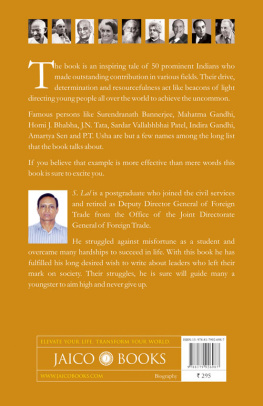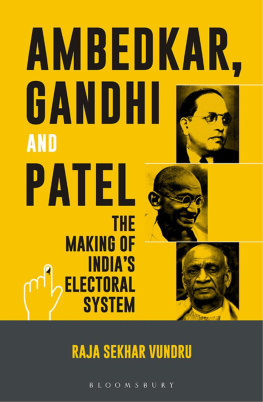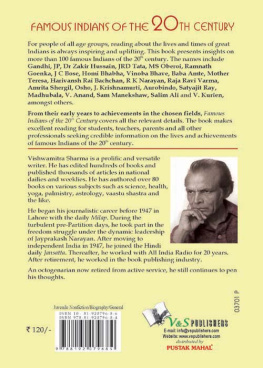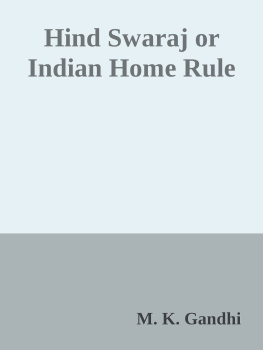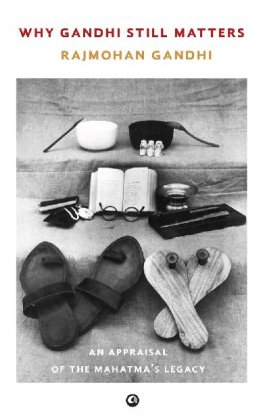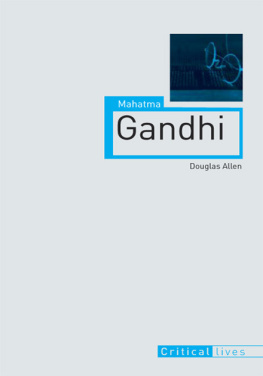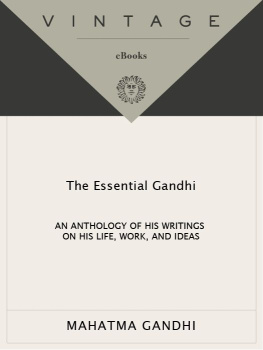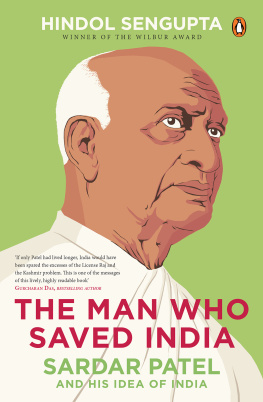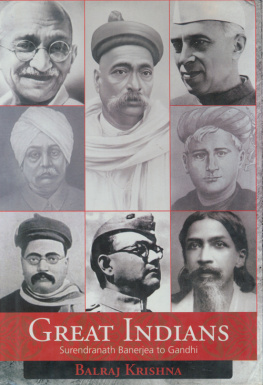
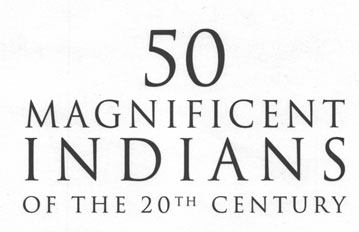
Published by Jaico Publishing House
A-2 Jash Chambers, 7-A Sir Phirozshah Mehta Road
Fort, Mumbai - 400 001
www.jaicobooks.com
S. Lal
50 MAGNIFICENT INDIANS OF THE 20TH CENTURY
ISBN: 978-81-7992-698-7
First Jaico Impression: 2008
Third Jaico Impression: 2011
No part of this book may be reproduced or utilized in
any form or by any means, electronic or
mechanical including photocopying, recording or by any
information storage and retrieval system,
without permission in writing from the publishers.
Printed by
Kaveri Printer, Delhi -92
DEDICATION
I most affectionately dedicate this book to the sweet and revered memoryof my grandmother, Smt. Rukmini Dew, who truly loved me since mybirth till she breathed her last on April 12, 1960.

PREFACE
I n selecting the fifty magnificent Indians, every effort has been made to maintain the secular character of India. The featured personalities represent almost all the major religions and regions of the nation. Some of them were born in the nineteenth century and lived through a part of the twentieth century; while others were born and lived to be an integral part of the twentieth century. However, there is one exception: hotelier-industrialist, Mohan Singh Oberoi, who was born on August 15, 1898, and died on May 3, 2002.
The first nine magnificient Indians have played a pioneering role in the Independence Movement. The remaining have made outstanding contributions in various other fields. The work and performance of each one of them, put together, has had a power-packed impact on the development and modernization of the country, besides adding to the nations overall strength. Most of the magnificiant Indians encountered hardships, which they overcame by their drive, determination and resourcefulness. Their importance, as a source of inspiration for future generations has grown manifold.
A Curtain Raiser
The British rule over India began in 1757, with the victory of the forces of the East India Company, against Nawab Siraj-ud-Daula, in the battle of Plassey. The main objective of the Company in India was to make money. This was achieved through their clever manipulation, with regards to the monopoly of trade. With the advent of the industrial revolution in the early nineteenth century, Britain had emerged as a leading industrial country, in the world. India was transformed into an ideal colony that became a major market for British products, as well as a supplier of raw materials and food to Britain. In 1866, Dadabhai Naoroji was in London to propagate Indias economic misery in order to influence the British public o pinion. He demonstrated that poverty and economic backwardness in India were actually fostered by colonial rule, which had been draining her wealth.
Political slavery was another gross injustice inflicted on Indians. They at that point could only survive within the limits set by their colonial rulers. Surendranath Bannerji had passed the ICS examination in 1869 a difficult feat at a time when the maximum age limit for Indian candidates was reduced to nineteen. Even then, he was removed from service on trivial grounds in 1874. Racial arrogance was the chief reason for being removed, as the foreigners were not happy to have him as their colleague. British colonial rule had harmed the lives of Indians in every way making it essential to organize Indias political life under the leadership of Surendranath Bannerji. He founded the Indian National Conference in 1883, which merged with the Indian National Congress in 1886, under the chairmanship of W C. Bannerjee.
Inhuman treatment meted out to Indians by the white people in South Africa, forced Gandhi to struggle for equal rights, for his countrymen. He launched the agitation of Satyagraha a unique technique born out of non-violence and truth in South Africa. This won equal rights for Indians, in 1914. He returned to India and plunged into the Independence Movement, in 1917. Having followed the philosophy of non-violence, all through his life, he ultimately led the Indian people to win Independence, in 1947.
A noble British lady, Annie Besant, adopted India as her motherland. She played an active and vital role in the struggle for the cause of Indian nationalism.
Tata is a prime name synonymous with industrialization of India. J. N. Tata, the patriarch of the family had foreseen, as far back as the 1860s, that Indias economic development could be achieved only through industrialization. He laid the foundation of Indias industrial base, which was followed by the Birla Group; and later by others.
India could not produce too many great scientists due to centuries of subjugation. Yet, the nation has given birth to the likes of Nuclear scientist, Dr. Homi J. Bhabha who had long ago recommended building an extensive scientific infrastructure in the country, in order to catch up with the more progressive countries.
The prime objective of a statesman is to render selfless service for the cause of national welfare. Sardar Vallabhbhai Patel was one such stalwart, whose historical service to the nation was marked by the integration of the princely states. Indira Gandhi emerged as the foremost politician during the post-independence phase by virtue of having been bold enough to implement vital decisions. The monumental achievement of her leadership was Indias victory in the Indo-Pak War, of 1971. Lal Bahadur Shastri was another exceptional leader, endowed with the strength of high moral character and honesty a rare virtue found in politics. He had set a unique example by resigning as the Railway Minister following a train accident in 1956, for which he personally owned responsibility. His example is yet to be emulated.
General Yayah Khan unleashed a regime of repression in March 1971, to crush the unrest in East Pakistan. It resulted in the massacre of over three million people and the influx of over ten million refugees into the Indian territory. Pakistan initiated the war that ended on December 16, 1971. India emerged victorious having captured Dhaka along with 93000 POWs. This war produced two great warriors Field Marshall Sam Mancekshaw and Admiral S. M. Nanda.
To date, Rabindranath Tagore, has been admired as the most universal and complete human being, by intellectuals all over the world. His literary persona covered subjects like, poetry, plays, novels and stories; in addition to innumerable songs including Indias national anthem Jana Gana Mana. His imagination was extensive and touched almost every aspect of life.
Jurists, namely, M. C. Setalvad and M. C. Chagla, represented a wide range of professions, concerning law. Both scaled great professional heights. M. C. Setalvad was appointed the Attorney General of India, before India became a Republic and continued to hold this position till 1962. Justice M. C. Chagla was the first Indian to become the Chief Justice of the Bombay High Court, on August 15, 1947.
In the initial stages women working in films were not respected in Hindu society. Likewise, the Parsee community too did not spare its women from this prejudice. The Muslim ruling classes had traditionally not regarded the film industry as a profession of disrepute. Hence, a large number of Muslim men and women, besides a small number of Anglo-Indians, had joined the film industry. However, a daring Brahmin socialite, Durga Khote, joined films in the early 1930s and paved the way for Hindu women to join the film industry.
Next page
